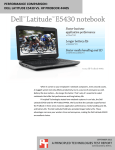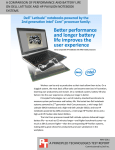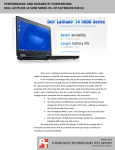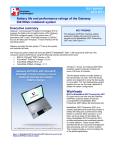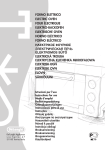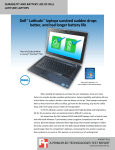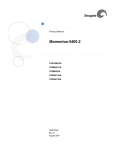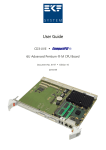Download Performance comparison of a Dell Latitude netbook and previous
Transcript
TEST REPORT OCTOBER 2009 Performance comparison of a Dell Latitude netbook and previous generation Dell Latitude notebooks Executive summary Dell Inc. (Dell) commissioned Principled Technologies (PT) to run a set of performance tests on a current Intel® processor-based Dell™ Latitude™ netbook and two previous generation Intel processor-based Dell Latitude notebook systems. We tested the following current Dell Latitude netbook system: Dell Latitude 2100 with Intel® Atom™ Processor N270 We compared performance of Microsoft Windows® 7 Ultimate (Windows 7), Microsoft Windows Vista® Ultimate SP2 (Windows Vista), and Windows® XP Professional SP3 (Windows XP) on the Dell Latitude netbook and of Windows XP on the following two previous generation Dell Latitude notebooks: Dell Latitude D610 notebook with Intel® Pentium® M Processor 740 (4-year-old system) Dell Latitude D620 notebook with Intel® Core™ Duo T2400 Processor (3-year-old system) KEY FINDINGS Appendix A provides detailed system configuration information. The current Dell Latitude 2100 netbook running Windows 7 provided up to 98% longer, or over 3 hours more, MobileMark 2007 battery life than that of the two previous generation Dell Latitude notebooks. (See Figure 1.) The current Dell Latitude 2100 netbook running Windows 7 booted 4% to 9% faster than did the two previous generation Dell Latitude notebooks. (See Figures 2 and 3). The current Dell Latitude 2100 netbook running Windows 7 achieved standby from 63% to 74% faster, and resumed from standby between 6% to 10% faster, than did the two Dell previous generation notebooks (See Figures 4 and 5.) The current Dell Latitude 2100 netbook running Windows 7 shut down between 2% to 3% faster than did the two Dell previous generation notebooks (See Figure 6.) We compared the systems in the areas of battery life, and system responsiveness. We used MobileMark 2007 v1.06 Productivity 2007 to test battery life performance, and used custom hand-time tests to measure system responsiveness. In most instances, we found that the Dell Latitude 2100 netbook running Windows 7 outperformed the previous generation Dell Latitude notebooks running Windows XP. Minutes (higher is better) BAPCo MobileMark 2007 v1.06 battery life rating 450 400 350 300 250 200 150 100 50 0 Dell Latitude D610 XP Professional SP3 Dell Latitude D620 Vista Ultimate SP2 Dell Latitude 2100 Windows 7 Ultimate Figure 1: BAPCo MobileMark 2007 results – Battery life. Higher numbers are better. Figure 1 shows the MobileMark 2007 v1.06 battery life results for the current Dell Latitude 2100 netbook running Windows 7, Windows Vista, and Windows XP, and the previous generation Dell Latitude notebooks running Windows XP. The Dell Latitude 2100 running Windows 7 outperformed the previous generation Dell Latitude D610 by 98 percent, or 185 minutes, and outperformed the previous generation Dell Latitude D620 by 81 percent, over 165 minutes. Minutes (lower is better) Boot experience Time to home page 1.00 0.75 0.50 0.25 0.00 Dell Latitude D610 XP Prof essional SP3 Dell Latitude D620 Vista Ultimate SP2 Dell Latitude 2100 Windows 7 Ultimate Figure 2: Boot experience results – Time to home page appearing in Internet Explorer 8 after booting notebook. Lower numbers are better. Boot experience Time to connect to Exchange server Minutes (lower is better) 1.00 0.75 0.50 0.25 Figure 2 shows the handtimed results for both the current Dell Latitude 2100 netbook and the previous generation Dell Latitude notebooks running Windows XP. We measured from the moment we pressed the power button to the point the home page appears in Internet Explorer 8. This takes into account not only the fact that the system has completed the boot process, but it has become usable, and has made its connection to the internet. Although we performed this test on both wireless and wired networks, we present the wireless results here, due to the much higher likelihood that an end-user will use this netbook in a wireless environment. The Dell Latitude 2100 netbook running Windows 7 outperformed the previous generation Dell Latitude D610 by 6 percent on this test, but lost to the Dell Latitude D620 by 3 percent. Figure 3 shows the handtimed results for both the current Dell Latitude 2100 Dell Latitude D610 Dell Latitude D620 Dell Latitude 2100 netbook and the previous generation Dell Latitude XP Prof essional SP3 Vista Ultimate SP2 Windows 7 Ultimate notebooks running Windows XP. The Dell Latitude 2100 Figure 3: Boot experience results – Time to connect to Exchange server after booting. Lower netbook running Windows 7 numbers are better. booted and subsequently connected to an Exchange server between 5 percent faster than the previous generation Dell Latitude D610, and 11 percent faster than the previous generation Dell Latitude D620. 0.00 Principled Technologies, Inc.: Performance comparison of a Dell Latitude netbook and previous generation Dell Latitude notebooks 2 Figure 4 shows the hand-timed results for putting the systems into standby. The Dell Latitude 2100 running Windows 7 achieved standby 63 percent faster than the previous generation Dell Latitude D610, and 27 percent faster than the previous generation Dell Latitude D620. Minutes (lower is better) Standby experience Time to go into standby 0.25 0.20 0.15 0.10 0.05 0.00 Dell Latitude D610 XP Prof essional SP3 Dell Latitude D620 Vista Ultimate SP2 Dell Latitude 2100 Windows 7 Ultimate Figure 4: Standby experience – Time to go into standby. Lower numbers are better. Minutes (lower is better) Standby experience Time to resume from standby Figure 6 shows the hand-timed results for shutting down the systems. The Dell Latitude 2100 netbook running Windows 7 shut down 15 percent faster than the previous generation Dell Latitude D610, and 6 percent faster than the previous generation Dell Latitude D620. 0.14 0.12 0.10 0.08 0.06 0.04 0.02 0.00 Dell Latitude D610 XP Prof essional SP3 Dell Latitude D620 Vista Ultimate SP2 Dell Latitude 2100 Windows 7 Ultimate Figure 5: Standby experience – Time to resume from standby. Lower numbers are better Fig. Minutes (lower is better) Shutdown experience Time to turn system off 0.25 0.20 0.15 0.10 0.05 0.00 Dell Latitude D610 XP Prof essional SP3 Dell Latitude D620 Vista Ultimate SP2 Figure 5 shows the hand-timed results for the systems resuming from standby. The Dell Latitude 2100 running Windows 7 resumed 79 percent faster than the previous generation Dell Latitude D610, and resumed 74 percent faster than the previous generation Dell Latitude D620. Dell Latitude 2100 Windows 7 Ultimate Figure 6: Shutdown experience– Time to turn system off. Lower numbers are better. . Workload MobileMark 2007 v1.06 MobileMark 2007 is an industrystandard benchmark BAPCo created to measure system battery life and performance. MobileMark 2007 measures system battery life in minutes. MobileMark 2007 records system battery life at the start of the Productivity 2007 benchmark, and repeats the benchmark workload until the system battery life is depleted, or until the notebook system powers down due to low battery life. At the 7 percent battery life setting, MobileMark 2007 records a timestamp once per minute. At the end of the benchmark, it compares the beginning timestamp to the final (last recorded) timestamp. Principled Technologies, Inc.: Performance comparison of a Dell Latitude netbook and previous generation Dell Latitude notebooks 3 MobileMark 2007 derives its system battery life rating as the number of minutes between the start and end timestamps. MobileMark 2007 Productivity 2007 consists of the following applications and corresponding tasks: Microsoft Project 2003 (project management), Microsoft Excel 2003 (calculation sheets), Microsoft Outlook 2003 (emails, calendars, scheduler), Microsoft PowerPoint 2003 (slide presentations), Microsoft Word 2003 (formatted text documents), WinZip Computing and WinZip Pro 10.0 (compressed archives), Adobe Photoshop CS2 (manipulated and compressed images), Adobe Illustrator CS2 (manipulated images), and Adobe Flash 8 (vector graphics, animation). We followed the run rules that MobileMark 2007 specifies here: http://www.bapco.com/support/mobilemark2007/Manual/rules.html. Test methodology In this section, we provide the methodology for two sets of tests: MobileMark 2007 v.1.06, and system responsiveness. For the system responsiveness tests, we ran each test three times, taking the median of the three runs. MobileMark 2007 v.1.06 Preparing to measure battery life with MobileMark 2007 v.1.06 We conditioned the battery prior to testing. To do so, we performed two complete drains of the battery, starting from a battery at 100 percent charge. To expedite the draining process, we ran the MobileMark 2007 Productivity 2007 test until the battery completely discharged. We recorded the room temperature at the beginning of each official run. Antivirus software conflicts MobileMark 2007 is not compatible with any virus-scanning software, so we uninstalled any such software that was present on the notebook PCs before we installed the benchmark. Pre-installed software conflicts MobileMark 2007 installs the following applications, which its test scripts employ: Adobe Photoshop 6.0.1 InterVideo WinDVD 6.0 Macromedia Flash 5.0 Microsoft Excel 2002 Microsoft Outlook 2002 Microsoft PowerPoint 2002 Microsoft Word 2002 Netscape Communicator 6.01 Network Associates McAfee VirusScan 5.13 WinZip Computing WinZip 8.0 If any of these applications are already on the system under test, they will cause problems with the benchmark due to software conflicts. To avoid any such issues, before we installed the benchmark, we uninstalled all conflicting pre-installed software applications, including different versions of any of the programs MobileMark 2007 uses. Installing MobileMark 2007 v.1.06 1. Reset the notebook to the base image using Symantec’s Ghost product. 2. Turn off the wireless network adapter by using the external toggle switch. 3. Insert the MobileMark 2007 Install DVD in the notebook PC’s DVD drive. 4. At the Welcome screen, click Next. 5. Accept the license agreement, and click Next. 6. At the Ready to Install the Program screen, click Install. Principled Technologies, Inc.: Performance comparison of a Dell Latitude netbook and previous generation Dell Latitude notebooks 4 7. Run the BAPCo Auto-configuration tool, v.1.3.2, to set the power options. a. Insert the Auto-configuration tool in the notebook PC’s DVD drive. b. Double-click BAPCo_AutoConfig.exe. c. Type M to choose MobileMark 2007. d. Type 3 to choose the changes that produce the best possible scores, as follows: 1. Set Critical battery alarm to 0%. 2. Set Low battery alarm to 0%. 3. Disable screen saver. 4. Stop and disable Windows Update. 5. Disable desktop cleanup wizard. 6. Disable Windows Security Center warnings. 7. Disable Windows Firewall. 8. Disable incoming Remote Desktop connections. 9. Disable Windows Error Reporting to Microsoft. 10. Disable Windows Defender. Displaying brightness and power settings Because the brightness of a notebook’s display affects its battery life, BAPCo required that, before we tested with MobileMark 2007, we made sure the brightness of the notebook’s monitor was greater than or equal to 60 nits on a completely white screen while the notebook was unplugged and running on battery power. The measurement follows the standards from the Video Electronics Standards Association (www.vesa.org/Standards/summary/2001_6a.htm). We complied with this standard for all the tests we ran by setting each notebook PC’s brightness as close to 60 nits as we could without going below that brightness level. We used the following procedure, which assumes we began with the notebook plugged into the power supply, to meet this requirement before we started each test: 1. To create a completely blank white screen, open Microsoft Paint by clicking StartAll ProgramsAccessoriesPaint. 2. Open the Attributes by pressing Ctrl+E. 3. Enter dimensions that are larger than the current screen resolution. For example, if the screen resolution is 1,280 x 800, enter 1,600 for Width and 1,200 for Height. 4. Click OK. 5. Press Ctrl+F to view the bitmap image and render the screen completely white. 6. Wait 45 minutes to allow the screen to warm. 7. Unplug the notebook from the power supply, and measure the display’s brightness using a luminance meter in the center of the screen. (We use the Gossen Mavolux5032C.) 8. If the reading is below or significantly greater than 60 nits, use the notebook’s keyboard screenbrightness-adjustment keys to bring the display as close to 60 nits as possible, then retest. 9. Allow the notebook to run on battery power for 10 minutes, re-measure the display, and adjust the brightness up or down as necessary. 10. Verify that the notebook saved the brightness setting by plugging in the system, unplugging it, and taking another reading. If the notebook did not save this setting, use its power-management application(s) to set the brightness appropriately, and save that setting. Conditioning the battery 1. Plug the AC power adapter into the notebook PC, and completely charge the battery. 2. Install MobileMark 2007 v1.05, following the steps we outlined in the Installing MobileMark 2007 section. 3. Double-click the MobileMark 2007 icon on the desktop. 4. Highlight the Productivity 2007 item in the left panel. 5. Enter a name for this test in the Project Name field at the top-right panel, and click Next Step. 6. If MobileMark lists no problems or warnings, click Next Step. If it does list any problems or warnings, close MobileMark 2007, and correct the problem(s) before proceeding. 7. Unplug the AC power adapter. The Productivity 2007 test begins immediately. 8. The test is complete when the notebook PC has fully depleted its battery and is no longer operational when running on battery power. Principled Technologies, Inc.: Performance comparison of a Dell Latitude netbook and previous generation Dell Latitude notebooks 5 9. Repeat steps 3 through 8 for the second conditioning run and for all official runs. 10. Plug the AC power adapter into the notebook PC, and completely charge the battery. Measuring battery life with MobileMark 2007 v.1.06 We performed the following steps to run the MobileMark Productivity 2007 benchmark: 1. Double-click the MobileMark 2007 icon on the desktop. 2. Select the Productivity 2007 test by highlighting it in the left panel. 3. Enter a name for this test in the Project Name field in the top right panel, and click Next Step. 4. If MobileMark lists no problems or warnings, click Next. If it does list any problems or warnings, close MobileMark 2007, and correct the problem(s) before proceeding. 5. Unplug the AC power adapter. The test begins immediately. 6. The Productivity 2007 test is complete when the notebook PC has fully depleted its battery and is no longer operational when running on battery power. We executed the Productivity 2007 test three times on each system configuration and used the average result of each set of three as the representative score for that test. 1. Configure the notebook with the standard battery and the BAPCo recommendations for running MobileMark 2007. 2. Execute the Productivity 2007 test three times in this configuration. 3. Configure the notebook with the maximum-sized battery available at the time of purchase and the BAPCo recommendations for running MobileMark 2007. 4. Execute the Productivity 2007 test three times in this configuration. Getting the MobileMark 2007 results After each MobileMark test completed, we plugged the AC power adapter into the notebook PC and turned on the system. MobileMark 2007 started automatically after the system booted, analyzed the test scores, and opened the Test Results Viewer with the results from the last test. To submit these results to BAPCo, we saved the test results directory. To do so, we performed the following steps: 1. Browse to the C:\ Program Files\BAPCo\MobileMark 2007\results directory. a. Select My Computer. b. Select Local Disk (C:). c. Select the Program Files directory. d. Select the BAPCo directory. e. Select the MobileMark2007 directory. f. Select the results directory. (Note: The name of the directory for the Productivity 2007 results is the name you gave the test in Step 6 of the MobileMark Productivity 2007 process.) System responsiveness tests Boot experience This test requires a stopwatch with multiple timers. Setting up the test 1. Reset the system to the base image. Running the test 1. Simultaneously start the timer and boot the system. 2. Stop timer 1 when the taskbar appears. 3. Launch Internet Explorer from the taskbar immediately after the taskbar appears. 4. Stop timer 2 when the home page appears. 5. Wait 3 minutes before shutting the system down. 6. Repeat steps 1 through 5 two times, and report the median. Principled Technologies, Inc.: Performance comparison of a Dell Latitude netbook and previous generation Dell Latitude notebooks 6 Boot experience with Outlook 2007 SP2 This test requires a stopwatch. This test requires no setup. Running the test 1. Boot the system. 2. Simultaneously launch Outlook and start the timer. 3. Stop the timer when the system connects to Microsoft Exchange, as indicated by the status bar in Outlook 2007. 4. Wait 3 minutes before shutting the system down. 5. Repeat steps 1 through 4 two times, and report the median. Standby experience with applications and Outlook 2007 SP2 open This test requires a stopwatch. This test requires no setup. We used the following test documents: TwoCities.docx 496 KB (507,904 bytes) Supply Requisition Form2.xlsx 820 KB (839,680 bytes) Welcome!.pptx 352 KB (360,448 bytes) Setting up the test 1. Reboot the system. Running the test 1. Launch Outlook, and wait until the system is online with Microsoft Exchange, as indicated by the status bar in Outlook 2007. 2. Launch PowerPoint, and open Welcome!.pptx. 3. Launch Excel, and open Supply Requisition Form2.xlsx. 4. Launch Word, and open TwoCities.docx. 5. Wait 5 minutes. 6. With the documents open, put the system in standby/sleep mode: StartTurn Off ComputerStandby (Windows XP) or StartSleep (Windows Vista, Windows 7). 7. Simultaneously start the timer and select Standby/Sleep. 8. Reset the timer. 9. Simultaneously start the timer and press the power button to resume from standby/sleep mode. 10. Stop the timer when the system is online with Microsoft Exchange, as indicated by the status bar in Outlook 2007. 11. Shut down the system. 12. Repeat steps 1 through 11 two times, and report the median, but do not shut down the system after the final timed run. Shutdown experience This test requires a stopwatch. This test requires no setup. Running the test 1. Wait 2 minutes. 2. Simultaneously start the timer and shut down the system: StartTurn Off ComputerShut Down (Windows XP), StartShut Down (Windows Vista, Windows 7). 3. Stop the timer when the system is completely shut down. 4. Boot the system. 5. Repeat steps 1 through 4 two times, and report the median. Principled Technologies, Inc.: Performance comparison of a Dell Latitude netbook and previous generation Dell Latitude notebooks 7 Appendix A – Detailed system configuration information Figure 12 presents each test system and the details of its configuration. Dell notebook systems General Processor and OS kernel: (physical, core, logical) / (UP, MP) System power management policy Windows XP System power management policy Windows Vista System power management policy Windows 7 Processor power-saving option System dimensions (length x width x height) System weight CPU Vendor Name Model number Stepping Socket type and number of pins Core frequency (GHz) Front-side bus frequency (MHz) L1 cache L2 cache (MB) Platform Vendor Motherboard model number Motherboard chipset Motherboard revision number System/motherboard serial number BIOS name and version BIOS settings Memory module(s) Vendor and model number Type Speed (MHz) Dell Latitude 2100 Dell Latitude D610 Dell Latitude D620 1P,1C,2L / MP 1P,1C,1L / UP 1P,2C,2L / MP Dell Mobile Battery Methodology Dell Mobile Battery Methodology Dell Mobile Battery Methodology Dell Mobile Battery Methodology NA NA Dell Mobile Battery Methodology NA NA EIST EIST EIST 10.5" x 7.75" x 2.25" 12.5" x 10.30" x 1.5" 13.25" x 9.5" x 1.5" 3 lbs. 4 oz. 5 lbs. 6 oz. 5 lbs. 5 oz. Intel Atom N270 C0 Intel Pentium M 740 C0 Intel Core Duo T2400 C0 Socket 437 Socket 479 Socket 479 1.6 1.73 1.83 533 MHz 533 667 24 KB + 32 KB 512 KB 32 KB + 32 KB 2 32 KB + 32 KB (per core) 2 Dell Dell Dell 0W785N 0M7181 0TD761 Intel i945GSE Intel i915GM Intel i945GM 03 03 03 B8L78K1 J8H54B1 BX49XB1 Dell A02 (08/11/2009) Default Dell A06 (10/02/2005) Default Dell A10 (05/16/2008) Default Elpida EBE11UE6AESA8G-F PC2-6400 533 Hyundai HYMP512S64BP8-C4 PC2-4200 533 Hyundai HYMP512S64BP8-Y5 PC2-5300 667 Principled Technologies, Inc.: Performance comparison of a Dell Latitude netbook and previous generation Dell Latitude notebooks 8 Dell notebook systems Speed running in the system (MHz) Timing/Latency (tCL-tRCDtRP-tRASmin) Size (MB) Number of memory module(s) Channel (single/dual) Hard disk Dell Latitude 2100 Dell Latitude D610 Dell Latitude D620 533 533 667 4-4-4-12 4-4-4-12 5-5-5-15 2,048 MB 1 x 1,024 MB integrated, 1 x 1,024 MB module Single 1,024 2,048 1 2 Single Dual Seagate ST9408114A Toshiba MK4034GSX 40 8 5,400 ATA-100 Microsoft 5.1.2600.5512 (07/01/2001) 40 8 5,400 SATA 1.5 Gb/s Intel 82801GHM (ICH7M/U) Intel 7.0.0.1020 (05/23/2005) NA NA NA NA Build number Service pack File system Microsoft Windows XP Professional 2600 3 NTFS Microsoft Windows XP Professional 2600 3 NTFS Microsoft Windows XP Professional 2600 3 NTFS Kernel ACPI Multiprocessor PC ACPI Uniprocessor PC ACPI Multiprocessor PC Language Microsoft DirectX version Windows Vista English 9.0c English 9.0c English 9.0c NA NA NA NA NA NA NA NA NA NA NA NA NA NA NA NA NA NA NA NA NA NA Vendor and model number Size (GB) Buffer size (MB) RPM Type Controller Driver Windows XP Driver Windows Vista Driver Windows 7 Western Digital WD800BEVT-75ZCT2 80 GB 8 MB 5,400 SATA 3.0 Gb/s Intel 82801GHM (ICH7M/U) Intel 8.8.0.1009 (02/11/2009) Intel 8.8.0.1009 (02/11/2009) Intel 8.9.2.1002 (08/07/2009) Intel 82801FBM (ICH6-M) Operating system Windows XP Name Name Build number Service pack File system Kernel Language Microsoft DirectX version Windows 7 Name Build number Service Pack File system Microsoft Windows Vista Ultimate 6002 2 NTFS ACPI x86-based PC English 10 Microsoft Windows 7 Ultimate 7600 NA NTFS Principled Technologies, Inc.: Performance comparison of a Dell Latitude netbook and previous generation Dell Latitude notebooks 9 Dell notebook systems Kernel Language Microsoft DirectX version Graphics Vendor and model number Type Chipset BIOS version Total available graphics memory (MB) Dedicated video memory (MB) System video memory (MB) Shared system memory (MB) Resolution Driver Windows XP Driver Windows Vista Driver Windows 7 Dell Latitude 2100 Dell Latitude D610 Dell Latitude D620 ACPI x86-based PC English 11 NA NA NA NA NA NA Mobile Intel GMA 950 Integrated Mobile Intel 945 Express Chipset ATI Mobility Radeon X300 Integrated Mobile Intel GMA 950 Integrated Mobile Intel 945GM Express Chipset ATI Mobility Radeon X300 1585.9 BK-ATI VER008.017M.192.062 1343 256 MB 64 224 0 MB NA NA 64 MB NA NA 192 MB NA NA 1,024 x 768 x 32 bit Intel 6.14.10.4926 (02/15/2008) Intel 7.15.10.1587 (10/22/2008) Intel 8.15.10.1867 (08/06/2009) 1,024 x 768 x 32 bit ATI 6.14.10.6568 (07/06/2005) 1,024 x 768 x 32 bit Intel 6.14.10.4814 (03/30/2007) NA NA NA NA Sound card/subsystem Vendor and model number Driver Windows XP Driver Windows Vista Driver Windows 7 Realtek High Definition Audio Realtek 5.10.0.5809 (03/12/2009) Realtek 6.0.1.5809 (03/12/2009) Realtek 6.0.1.5886 (07/02/2009) SigmaTel 5.10.0.4255 (03/11/2005) SigmaTel High Definition Audio CODEC SigmaTel 5.10.0.5515 (05/10/2007) NA NA NA NA Broadcom NetXtreme 57xx Gigabit Broadcom 7.86.0.0 (08/23/2004) Broadcom NetXtreme 57xx Gigabit Broadcom 8.48.0.0 (10/31/2005) NA NA NA NA SigmaTel C-Major Audio Ethernet Vendor and model number Driver Windows XP Driver Windows Vista Driver Windows 7 Broadcom NetXtreme 57xx Gigabit Broadcom 11.7.2.0 (11/26/2008) Broadcom 11.7.2.0 (10/22/2008) Broadcom 12.2.0.3 (05/28/2009) Principled Technologies, Inc.: Performance comparison of a Dell Latitude netbook and previous generation Dell Latitude notebooks 10 Dell notebook systems Dell Latitude 2100 Dell Latitude D610 Dell Latitude D620 Wireless Vendor and model number Driver Windows XP Driver Windows Vista Driver Windows 7 Dell Wireless 1397 WLAN Mini-Card Broadcom 5.10.79.14 (02/20/2009) Broadcom 5.10.79.14 (02/20/2009) Broadcom 5.30.21.0 (07/07/2009) Dell Wireless 1470 Dual Band WLAN Mini-PCI Card Broadcom 4.100.15.5 (10/12/2006) Dell Wireless 1490 Dual Band WLAN Mini-Card Broadcom 5.10.79.14 (02/20/2009) NA NA NA NA NA NA NA NA NA NA NA NA Conexant HDA D110 MDC V.92 Conexant 7.38.0.0 (12/02/2005) NA NA Bluetooth Vendor and model number Driver Windows XP Driver Windows Vista Driver Windows 7 Modem NA NA NA NA Vendor and model number NA Driver Windows XP NA Driver Windows Vista Driver Windows 7 Optical drive(s) Vendor and model number Type Interface Dual/Single layer USB ports Number Type Other IEEE 1394 ports Number Power adapter Type Monitor LCD type Screen size Refresh rate (Hz) Battery Type Size (length x width x height) Rated capacity Weight (oz) NA NA Conexant HDA D110 MDC V.92 Conexant 7.23.1.0 (05/03/2005) NA NA NA NA NA NA TEAC DV28EV DVD-ROM ATA NA Optiarc AD-5540A DVD-RW ATA Single 3 USB 2.0 Media card reader 4 USB 2.0 NA 4 USB 2.0 NA NA NA NA Dell LA65NS1-00 65W Dell DA90PS1-00 90W Dell DA90PS1-00 90W WSVGA 10.1" 60 XGA 14.1" 60 WXGA 14.1" 60 Dell G038N lithium-ion Dell C1295 lithium-ion Dell PC764 lithium-ion 8" x 1.75" x 1.75" 5" x 3" x .80" 7.25" x 2.6" x .9" 5050 mAh / 11.1V (56Wh) 12 4700 mAh / 11.1V (53Wh) 11 5050 mAh / 11.1V (56Wh) 12 Figure 12. Detailed system configuration for the test systems. Principled Technologies, Inc.: Performance comparison of a Dell Latitude netbook and previous generation Dell Latitude notebooks 11 Appendix B – Detailed results Figures 13 and 14 present the detailed test results for the systems. Previous generation notebook systems Operating system Dell Latitude D610 Dell Latitude D620 XP Professional SP3 XP Professional SP3 Boot experience: Time to taskbar - median 00:29.73 00:27.65 Boot experience: Time to home page load - median Boot experience: Time to connect to Exchange Server after booting system - median Standby experience: Time to go into standby - median 00:15.54 00:13.55 00:15.73 00:20.88 00:07.13 00:03.59 Standby experience: Time to resume from standby - median 00:07.96 00:06.39 Time to turn system off - median 00:13.42 00:12.22 On/off tests (Lower is better) BAPCo MobileMark 2007 1.06 Battery Life Rating (Higher is better) Battery Life - median 189.00 207.00 Performance Qualification - median 123.50 161.00 Figure 13: Detailed test results for the previous generation notebook systems. Current notebook systems Operating system Dell Latitude 2100 Dell Latitude 2100 Dell Latitude 2100 XP Professional SP3 Vista Ultimate SP2 Windows 7 Ultimate 00:25.13 00:46.70 00:28.89 00:13.51 00:07.75 00:03.47 00:13.41 00:09.68 00:12.53 00:07.25 00:03.23 00:02.67 00:02.93 00:03.74 00:02.21 00:10.26 00:10.90 00:12.41 On/off tests (Lower is better) Boot experience: Time to taskbar - median Boot experience: Time to home page load median Boot experience: Time to connect to Exchange Server after booting system - median Standby experience: Time to go into standby median Standby experience: Time to resume from standby - median Time to turn system off - median BAPCo MobileMark 2007 1.06 Battery Life Rating (Higher is better) Battery Life - median 379.00 374.00 350.00 Performance Qualification - median 248.00 238.00 228.00 Figure 14: Detailed test results for the current notebook systems. Principled Technologies, Inc.: Performance comparison of a Dell Latitude netbook and previous generation Dell Latitude notebooks 12 About Principled Technologies We provide industry-leading technology assessment and fact-based marketing services. We bring to every assignment extensive experience with and expertise in all aspects of technology testing and analysis, from researching new technologies, to developing new methodologies, to testing with existing and new tools. When the assessment is complete, we know how to present the results to a broad range of target audiences. We provide our clients with the materials they need, from market-focused data to use in their own collateral to custom sales aids, such as test reports, performance assessments, and white papers. Every document reflects the results of our trusted independent analysis. We provide customized services that focus on our clients’ individual requirements. Whether the technology involves hardware, software, Web sites, or services, we offer the experience, expertise, and tools to help you assess how it will fare against its competition, its performance, whether it’s ready to go to market, and its quality and reliability. Our founders, Mark L. Van Name and Bill Catchings, have worked together in technology assessment for over 20 years. As journalists, they published over a thousand articles on a wide array of technology subjects. They created and led the Ziff-Davis Benchmark Operation, which developed such industry-standard benchmarks as Ziff Davis Media’s Winstone and WebBench. They founded and led eTesting Labs, and after the acquisition of that company by Lionbridge Technologies were the head and CTO of VeriTest. Principled Technologies, Inc. 1007 Slater Road, Suite 250 Durham, NC 27703 www.principledtechnologies.com [email protected] Principled Technologies is a registered trademark of Principled Technologies, Inc. All other product names are the trademarks of their respective owners. Disclaimer of Warranties; Limitation of Liability: PRINCIPLED TECHNOLOGIES, INC. HAS MADE REASONABLE EFFORTS TO ENSURE THE ACCURACY AND VALIDITY OF ITS TESTING, HOWEVER, PRINCIPLED TECHNOLOGIES, INC. SPECIFICALLY DISCLAIMS ANY WARRANTY, EXPRESSED OR IMPLIED, RELATING TO THE TEST RESULTS AND ANALYSIS, THEIR ACCURACY, COMPLETENESS OR QUALITY, INCLUDING ANY IMPLIED WARRANTY OF FITNESS FOR ANY PARTICULAR PURPOSE. ALL PERSONS OR ENTITIES RELYING ON THE RESULTS OF ANY TESTING DO SO ATTHEIR OWN RISK, AND AGREE THAT PRINCIPLED TECHNOLOGIES, INC., ITS EMPLOYEES AND ITS SUBCONTRACTORS SHALL HAVE NO LIABILITY WHATSOEVER FROM ANY CLAIM OF LOSS OR DAMAGE ON ACCOUNT OF ANY ALLEGED ERROR OR DEFECT IN ANY TESTING PROCEDURE OR RESULT. IN NO EVENT SHALL PRINCIPLED TECHNOLOGIES, INC. BE LIABLE FOR INDIRECT, SPECIAL, INCIDENTAL, OR CONSEQUENTIAL DAMAGES IN CONNECTION WITH ITS TESTING, EVEN IF ADVISED OF THE POSSIBILITY OF SUCH DAMAGES. IN NO EVENT SHALL PRINCIPLED TECHNOLOGIES, INC.’S LIABILITY, INCLUDING FOR DIRECT DAMAGES, EXCEED THE AMOUNTS PAID IN CONNECTION WITH PRINCIPLED TECHNOLOGIES, INC.’S TESTING. CUSTOMER’S SOLE AND EXCLUSIVE REMEDIES ARE AS SET FORTH HEREIN. Principled Technologies, Inc.: Performance comparison of a Dell Latitude netbook and previous generation Dell Latitude notebooks 13













